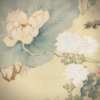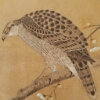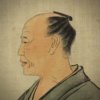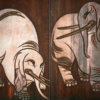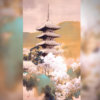Hirafuku Hyakusui: A Japanese-Style Painter Who Integrated the Both Elements of Rinpa and Nanga School and Developed His Unique Painting Style
Morning Dew

Hirafuku Hyakusui was born in Akita Prefecture as the fourth son of Hirafuku Suian who was a painter of the Shijō school. At the age of 13, he began to learn painting from his father, but when his father died the following year, he moved to Tokyo and became an apprentice to Kawabata Gyokusho, who was a close friend of his father, Suian. In 1894, at the age of 17, he was awarded the 3rd prize at the 3rd annual exhibition of the Japan Young Artists Association. In 1897, at the age of 20, at the suggestion of his friend Somei Yuki, he entered the Japanese Painting Department of the Tokyo School of Fine Arts. In 1900, he formed the Musei-kai with Yuki Somei and Fukui Kotei and advocated naturalism. He continued to be active in the Musei-kai for more than ten years, and also participated in the Bunten and Teiten exhibitions. In 1914, his “Turkey” won the 3rd prize at the 8th Bunten exhibition. The following year, he exhibited his work “Morning Dew” at the 9th Bunten exhibition and received a commendation, which was purchased by the Imperial Household Agency. He also formed the Kinrei-sha (an art association in the Taisho era) together with Yūki Somei, Kaburagi Kiyokata, Matsuoka Eikyū, Kikkawa Reika, and others in 1916. In 1926, he became a Teiten exhibition juror and exhibited his work titled “Araiso (Rugged Shore)”. Making good use of the opportunity, he frequently participated in the Teiten exhibition afterward. In 1932, he succeeded Kobori Tomoto as a professor at the Tokyo School of Fine Arts, where he was responsible for teaching the younger generation. In 1933, while returning to his hometown after receiving news of his second brother’s death, he died suddenly of a stroke. He was fifty-seven years old.
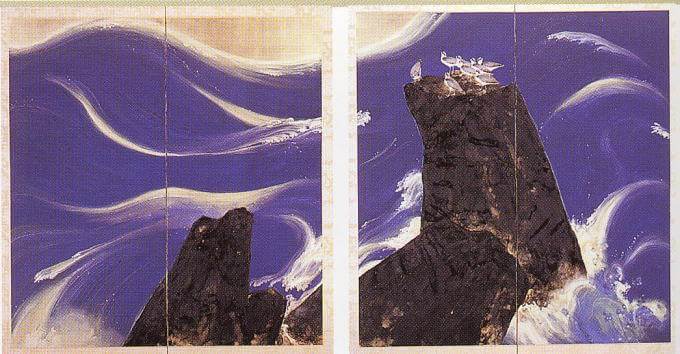
As mentioned earlier, the work ”Morning Dew” was exhibited at the 9th Bunten exhibition in 1915, and received a commendation, and was purchased by the Imperial Household Agency. It is a painting of silver grass and autumn weeds that fills the entire screen of a six-panel Byōbu screen. The leaves of the silver grass are covered with morning dew. The lingering moon, which has not yet disappeared is reflected in it. The grasses are depicted using the “tarashikomi” technique, indicating that Hyakusui had already studied the Rinpa school. This is a representative work from the middle age of Hyakusui.
Turkey

Tōri Gōsō (Chrysanthemums Bloom Despite the Cold at East Fence)

The work “Turkey,” is probably one of the patterns of “Turkey,” which was exhibited at the 8th Teiten exhibition in 1914 and won the 3rd prize. At that time, he painted several other turkeys, and this must be one of them. It is thought to have been produced around 1919. The screen, which was exhibited at the Bunten exhibition, is a large six-panel painting with six turkeys on the right screen and three on the left, painted only in ink. He used the “tarashikomi” technique of the Rinpa school to portray turkeys with shades of black ink, which is a remarkable technique. In this painting, just a single turkey is depicted on a large vertical hanging scroll. To maintain the proportion balance of the space, a small flowering plant is placed on the left foreground. The representation of the turkey by Sumi black ink shows the precision of Hyakusui’s painting technique.
The painting “Tōri Gōsō (Chrysanthemums Bloom Despite the Cold at East Fence)” is probably based on a poem by Tao Yuanming. It depicts chrysanthemums over a brushwood fence with powerful brushwork. The rough touch of the fence, the silhouette of the chrysanthemum leaves in dark ink, and the line drawing of the chrysanthemum flowers are depicted in contrast. The chrysanthemums look particularly bright.
- Tarashikomi: A high-level technique of Japanese-style painting for attaining natural blur by making use of the difference in the specific gravity of pigments.
Pine Tree and Cranes
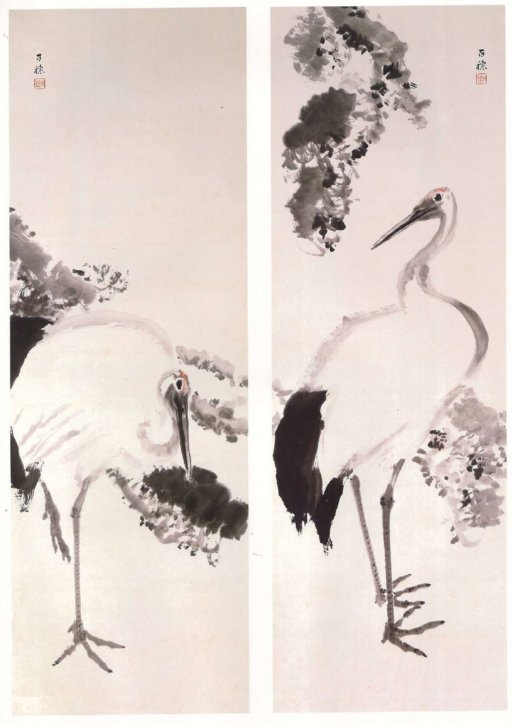
Baika Kanjaku (Plum Blossom and Winter Sparrow)

Hyakusui’s works have two aspects: one is the Rinpa style and the other is the Nanga style. It is not that two aspects are seen in one work. They are rather drawn as separate work. Hyakusui took his first painting lessons from his father, Suian, who was a painter of the Shijo school, and later moved to Tokyo to study under Kawabata Gyokusho, who was also a painter of the Shijo school. Therefore, concerning a school of Japanese painting, Hyakusui should be a painter of the Shijo school. Oddly though, very few of Hyakusui’s works are produced in the style of the Shijo school. Most of them are produced in the style of the Rinpa and Nanga schools. Instead of merely inheriting the style of the painting school, this is the germination and development of his individuality as a modern painter. The Rinpa school has a richly decorative style, while Nanga has a strong spirituality. Hyakusui could switch them according to his intended purpose. Examples of Rinpa style works include “Turkey” (1914), “Morning Dew” (1915), and “Araiso (Rugged shore)” (1926). His Nanga style works include “Sōshō (Double Pine Trees)” (1917), “Ikaruga no Atari (Scene around Ikaruga)” (1920), “Kari-kusa (Weed)” (1931), and “Komatsu-yama (Mt. Komatsu)” (1932).
It can be said that Hyakusui created works that appear to be completely superficially and visually different. Looking at the dates of the paintings, we can see that he was not partial to one or the other, but depicted both as appropriate. Gradually, two aspects began to appear in a piece of work. This can be seen from around 1930, and after “Kari-kusa (Weed)”, it evolved into “Plateau” and “Komatsu-yama (Mt. Komatsu) which he painted before his death. As seen in these 3 works, we would like to think that he composed his paintings in the style and spirit of Nanga and gave them a Rinpa-style decorative quality through the use of color. In this way, the two sides of Hyakusui’s artistic personality were integrated from each work into a single work, and thus he developed his unique world.
The “Pine Tree and Cranes” is a set of two hanging scrolls with an old pine tree and a crane on either side, drawn with quite a powerful touch. It is somewhat unusual for Hyakusui to draw pine trees with a careless touch, and to draw cranes with such rough outlines. This work is, after all, considered to be done in Nanga style. “Plum Blossom and Winter Sparrow” is simple work. There is only the plum tree with a vertical growing trunk and a thin branch with blossoms and a sparrow perched on a bent branch. The rough touch of the thick trunk and the delicate depiction of the thin branch are in contrast, creating a refreshing and magnificent atmosphere. The composition is also interesting. Hyakusui only painted on the left half of the vertical screen. The work was probably made around 1919.

